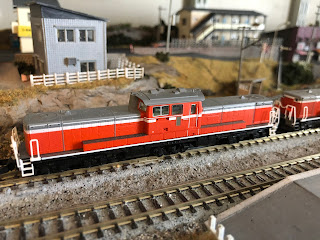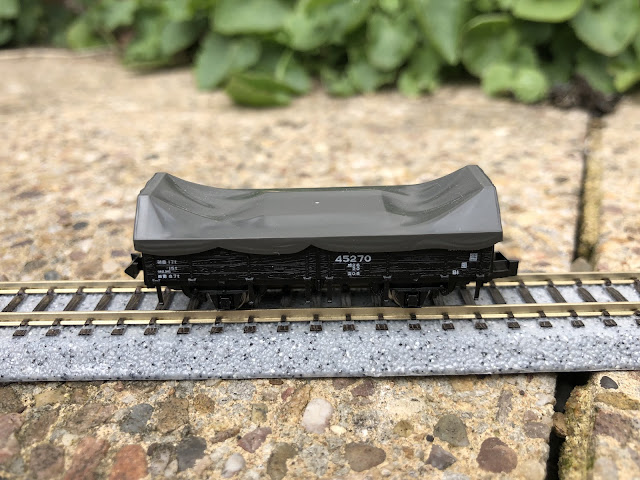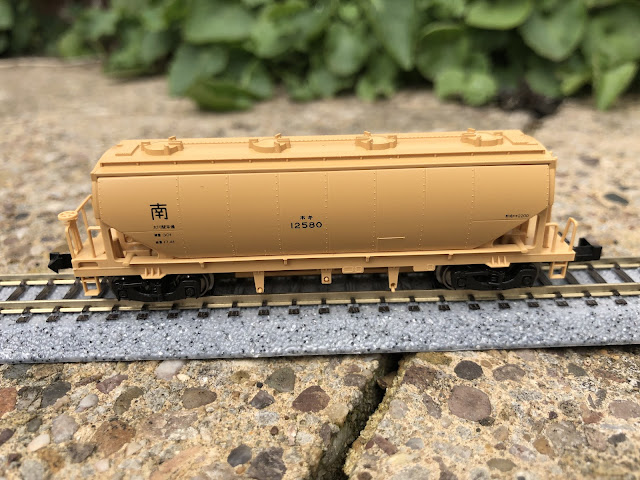Both Kato and Tomix produce models of this useful diesel locomotive.
There's a really detailed comparison of the two models here (in Japanese) that focuses on the appearance of each model. So, what follows is more on the features and performance of each model from the perspective of someone outside of Japan more used to European or North American models.
Background
The DD51 diesel-hydraulic locomotives were built in large numbers by Kawasaki, Hitachi, and Mitsubishi between 1962 and 1978. Although they resemble centre cab locomotives like the German V100 and British Class 17, the DD51 locomotive was bigger and more powerful. However, to keep the axle load down, the 78 to 84 ton locomotives were given an unusual Bo-2-Bo wheel arrangement. In other words, while the front and back bogies have powered axles, the bogie in the centre is not powered and instead helps to spread out the weight.
Two V12 diesel engines provide up to 2,200 HP and use a Voith hydraulic transmission to drive the axles. The locomotives have a maximum speed of 95 km/h (about 6o mph), adequate for freight trains but somewhat limiting as far as passenger work goes. Still, the earlier versions (known as the 0-series and 500-series) were equipped with steam generators to heat passenger coaches. This was instealled in a cabinet inside the larger central cab. However, the final series of locomotives, the 800-series, lacked the steam generator and was intended primarily for freight train operations.
While the 0-series lacked multiple unit control gear, the 500- and 800-series locomotives could be operated in multiple and were often found working in pairs.
Designed for both passenger and freight work, these were for a long time the standard 'mixed traffic' diesel locomotive of the Japanese railway system. Until displaced by electric or diesel multiple units, they were often assigned to local passenger trains that had once been worked by steam locomotives. In later years they were primarily used as freight engines on non-electrified routes, but some notable passenger workings in more recent times included the Imperial train (specifically, locomotive DD51 842) and sleeper trains on the island of Hokkaido.
At first glance, DD51s all look pretty similar. However, there are some minor differences between different series. The earliest 0-series locomotives have circular headlamps that protrude from the end of the bonnet, whereas all the later DD51s have headlights recessed into the bonnet in a much more aesthetically pleasing way. The 500- and 800-series locomotives also have cooling fans in the cab, revealed by either two or one protrusion on the roof respectively.
An important distinction is between the warm, cold, and semi-cold specifications. The warm climate specification is the basic model that generally lacks features suited to the cold and snowy conditions common in some parts of Japan. These can be found widely across central and southern parts of the main island (Honshu) including Tokyo.
The cold specification (known as the A-specification) is for very cold environments including the northernmost part of Honshu (the Tohoku region) and the island of Hokkaido. The cold specification DD51s have equipment to prevent flexible hoses and pipes from freezing as well as snow ploughs and ice protection for the windows. Their most characteristic feature, though, are the circular, rotating window panes designed to ensure the driver can see clearly, even in heavy snow.
The semi-cold specification (or B-specification) is designed for the fairly cold western part of Honshu, the Chugoku region, which includes the city of Hiroshima. This part of Japan is colder than its latitude might suggest, but not so cold as Hokkaido. The semi-cold DD51s have most of the features seen on the cold specification ones, but most notably (for modellers at least) lack the rotating windows.
As you'd expect for a class of locomotives that operated from the mid 1960s well into the 2010s, they were painted in many different liveries over the years.
The Tomix (2219) model

What's in the box?
- DD51-1000 locomotive, semi-cold (B) specification
- Removeable snowploughs
- Working headlights
- Chemically blackened wheels
- Optional roof (without cooling fans)
- Switch (inside the cab) to turn off the headlights
- Plastic sprues with number plates, maker plates, and radio antennas
- Replacement knuckle couplers (Arnold-type pre-fitted)
- Four different passenger train headboards
- Optional weight
- Very detailed, four-page instruction leaflet (in Japanese)
As the list of optional parts above should indicate, the model is supplied unnumbered so that it can be personalised as needed. There are four different sets of numbers. Once cut off their sprues, these plates are pushed into positioning holes where they sit quite securely. This is a bit of a faff, but it does mean that you can have several examples of the same model on your layout, all with different running numbers.
The cab clips away quite easily, revealing a small switch for turning off the headlights. This is useful where you're running two locos together, as the one at the back would not normally have its headlights on.
The model runs extremely well. It's smooth and quiet. Apparently, the DD51 was the first Tomix model to feature a flywheel! Current collection is from the front and back bogies but not the center bogie. Compared with the Kato model, but like other Tomix models, the Arnold coupler is rather large. A metal weight is included in the box that can be installed inside the cab to improve traction, but this hardly seems necessary. While you might get a bit more haulage or better grip on steep gradients, the weight will take up some of the space inside the cab.
The Kato (7008-H) Model

- DD51-1000 locomotive, cold (A) specification
- Removeable snowploughs
- Working headlights
- Chemically blackened wheels
- Plastic sprues with three different sets of number plates
- Replacement knuckle couplers (Arnold-type pre-fitted)
- Two-page instruction leaflet (in Japanese)
Another very smooth, very quiet model that performs just as well, if not better, than the Tomix one. There are fewer extra parts included in the box, but otherwise detailing is just as good. There are some key differences in appearance though, reflecting the type of locomotive featured here. As a 'late' model DD51, circa 2003/2004, this model features a radio antenna on the front of the cab used for ship-to-shore communications. Circular (rotating) windows indicate that this is the full cold specification type designed for use in snowy, icy environments.
Like the Tomix model, the middle bogie does not collect current. On the other hand, brass flywheels on the motor ensure the model has exceptionally smooth, steady acceleration. The model is even more fun when used with the Kato
Sound Box and the
DD51 Sound Card. This gives you a nice variety of sounds including engine starts, revving when the load, gradient, or speed increase, and three different whistles.
Conclusion
Neither model is what you'd call DCC-ready in the sense of having a standard slot into which a decoder can be installed. But other than that, both the Kato and Tomix models are excellent. I'd have no qualms buying either model or running them together as a double-header. They run extremely well, even through insulated frog points and tight (~30 cm) radius curves. Even though the Tomix one comes with a few extra options and detailing parts, there's otherwise nothing much to choose between them when it comes to livery and detail.
At the time of writing this, the models retail in Japan for around 9,000-10,000 Yen, about £40-50. So, they're quite cheap when compared to European and British N-scale models, especially. But with that said, if you buy them from Japan rather than locally, you're going to pay a significant amount in shipping -- and perhaps twice that if you need to send it back because it doesn't work! When it comes to buying locally versus ordering from Japan, you pays your money and you takes your choice.





















